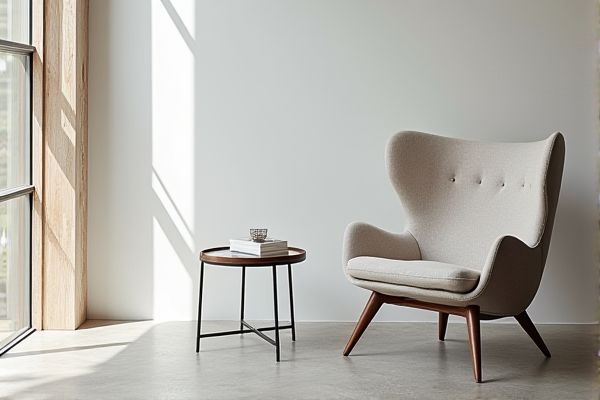
Acrylic chairs offer sleek designs and vibrant color options but tend to be less durable and more prone to scratches compared to polycarbonate chairs, which are known for their exceptional strength, impact resistance, and clarity. Discover the key differences and benefits of each material to make the best choice for your seating needs in the rest of the article.
Table of Comparison
| Feature | Acrylic Chair | Polycarbonate Chair |
|---|---|---|
| Material Composition | Polymethyl methacrylate (PMMA) | Polycarbonate (PC) |
| Durability | Good scratch resistance, moderate impact strength | High impact resistance, very durable |
| Transparency | Crystal clear, glass-like clarity | Clear but slightly less transparent than acrylic |
| Flexibility | Rigid and less flexible | Highly flexible and resistant to cracking |
| Weight | Lightweight | Moderately lightweight |
| UV Resistance | Moderate, can yellow over time | Excellent, resists yellowing |
| Cost | Generally lower cost | Higher cost due to durability |
| Use Case | Stylish indoor seating, decorative | Heavy-use seating, outdoor and commercial use |
Introduction to Acrylic and Polycarbonate Chairs
Acrylic chairs are known for their clarity, lightweight nature, and resistance to scratches, making them a stylish and durable choice for modern interiors. Polycarbonate chairs offer superior impact resistance, greater flexibility, and higher heat tolerance, ideal for environments requiring heavy use and safety features. Understanding the differences between acrylic and polycarbonate materials helps you choose the best chair for your needs regarding aesthetics, strength, and long-term performance.
Material Composition: Acrylic vs Polycarbonate
Acrylic chairs are made from polymethyl methacrylate (PMMA), a lightweight and transparent thermoplastic known for its glass-like clarity and resistance to UV light, making it ideal for indoor use with minimal yellowing over time. Polycarbonate chairs consist of a tougher, more impact-resistant thermoplastic that offers superior strength and durability, often used in settings where high resistance to breakage is essential. While acrylic provides a more rigid and brittle texture, polycarbonate delivers greater flexibility and shatter resistance, influencing both the longevity and safety of the furniture.
Durability and Strength Comparison
Acrylic chairs offer moderate durability with good resistance to impact but can scratch and crack under heavy stress, while polycarbonate chairs provide exceptional strength and nearly unbreakable performance due to their high impact resistance. The molecular structure of polycarbonate allows it to withstand extreme pressure and temperature changes, making it ideal for long-term use in demanding environments. Your choice should consider that polycarbonate chairs maintain their integrity better over time, especially in settings prone to frequent use and potential damage.
Visual Appeal and Transparency
Acrylic chairs offer superior clarity and a glass-like appearance, making them ideal for spaces that benefit from high transparency and modern aesthetics. Polycarbonate chairs provide durable, impact-resistant transparency but often have a slightly less crystal-clear finish compared to acrylic. Your choice depends on whether you prioritize exquisite visual appeal with vivid clarity or enhanced strength with durable transparency.
Weight and Portability Differences
Acrylic chairs typically weigh more than polycarbonate chairs due to the density of the acrylic material, making polycarbonate options more portable and easier to move for events or everyday use. Polycarbonate's lightweight properties enhance its suitability for spaces requiring frequent rearrangement, offering durability without the bulk. Choosing polycarbonate chairs supports both mobility and practicality, particularly in dynamic or compact environments.
Resistance to Scratches and Impact
Acrylic chairs offer moderate resistance to scratches but can be prone to visible marks over time due to their softer surface. Polycarbonate chairs provide superior impact resistance, making them highly durable and less likely to crack or break under stress. Polycarbonate's scratch resistance is also higher than acrylic, ensuring a longer-lasting clear and smooth appearance in high-use environments.
Maintenance and Cleaning Requirements
Acrylic chairs require gentle cleaning with a soft cloth and mild soap to prevent scratching and maintain clarity, avoiding abrasive cleaners that can damage the surface. Polycarbonate chairs offer higher resistance to impact and are easier to clean, tolerating stronger detergents and frequent wiping without clouding or cracking. Your choice should consider the maintenance effort you are willing to invest, as polycarbonate tends to be more durable and low-maintenance compared to acrylic.
Cost and Affordability Analysis
Acrylic chairs typically offer a more budget-friendly option compared to polycarbonate chairs, with prices often 20-30% lower due to cheaper raw materials and simpler manufacturing processes. Polycarbonate chairs, while more expensive, provide greater durability and impact resistance, which can justify the higher investment for long-term use and commercial settings. Evaluating total cost of ownership, acrylic chairs suit short-term or decorative use, whereas polycarbonate chairs deliver enhanced lifespan and value for frequent or heavy-duty applications.
Environmental Impact and Sustainability
Acrylic chairs are derived from petroleum-based materials and tend to have a higher environmental footprint due to less efficient recycling processes. Polycarbonate chairs offer improved sustainability as they are more durable and can be recycled multiple times, reducing waste in landfills. Choosing a polycarbonate chair can support your commitment to eco-friendly furniture by minimizing environmental impact over its lifecycle.
Choosing the Right Chair for Your Space
Acrylic chairs offer a sleek, modern look with high durability and resistance to UV light, making them ideal for both indoor and outdoor settings. Polycarbonate chairs provide exceptional impact resistance and flexibility, suitable for high-traffic areas where sturdiness is essential. Selecting the right chair depends on the balance between aesthetic preferences, usage environment, and required durability.
 homyna.com
homyna.com